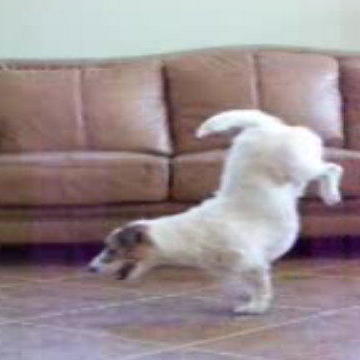https://www.youtube.com/watch?v=8Fcl5Iq1KEk

The domestic dog (Canis lupus familiaris or Canis familiaris) is a member of genus Canis (canines) that forms part of the wolf-like canids, and is the most widely abundant carnivore. The dog and the extant gray wolf are sister taxa, with modern wolves not closely related to the wolves that were first domesticated. The dog was the first domesticated species and has been selectively bred over millennia for various behaviors, sensory capabilities, and physical attributes.
Their long association with humans has led dogs to be uniquely attuned to human behavior and they are able to thrive on a starch-rich diet that would be inadequate for other canid species. Dogs vary widely in shape, size and colours. They perform many roles for people, such as hunting, herding, pulling loads, protection, assisting police and military, companionship and, more recently, aiding handicapped individuals. This influence on human society has given them the sobriquet “man’s best friend”.
It is estimated that three-quarters of the world’s dog population lives in the developing world as feral, village, or community dogs, with pet dogs uncommon.
“The most widespread form of interspecies bonding occurs between humans and dogs” and the keeping of them as companions, particularly by elites, has a long history. (As a possible example, at the Natufian culture site of Ain Mallaha in Israel, dated to 12,000 BC, the remains of an elderly human and a four-to-five-month-old puppy were found buried together). However, pet dog populations grew significantly after World War II as suburbanization increased. In the 1950s and 1960s, they were kept outside more often than they tend to be today (using the expression “in the doghouse” to describe exclusion from the group signifies the distance between the doghouse and the home) and were still primarily functional, acting as a guard, children’s playmate, or walking companion. From the 1980s, there have been changes in the role of the pet dog, such as the increased role of them in the emotional support of their human guardians. People and dogs have become increasingly integrated and implicated in each other’s lives, to the point where pet dogs actively shape the way a family and home are experienced.
There have been two major trends in the changing status of pet dogs. The first has been the ‘commodification’ of the dog, shaping it to conform to human expectations of personality and behaviour. The second has been the broadening of the concept of the family and the home to include dogs-as-dogs within everyday routines and practices.
Source : wikipedia

